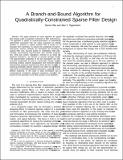A Branch-and-Bound Algorithm for Quadratically-Constrained Sparse Filter Design
Author(s)
Wei, Dennis; Oppenheim, Alan V.
DownloadOppenheim_A branch.pdf (648.1Kb)
OPEN_ACCESS_POLICY
Open Access Policy
Creative Commons Attribution-Noncommercial-Share Alike
Terms of use
Metadata
Show full item recordAbstract
This paper presents an exact algorithm for sparse filter design under a quadratic constraint on filter performance. The algorithm is based on branch-and-bound, a combinatorial optimization procedure that can either guarantee an optimal solution or produce a sparse solution with a bound on its deviation from optimality. To reduce the complexity of branch-and-bound, several methods are developed for bounding the optimal filter cost. Bounds based on infeasibility yield incrementally accumulating improvements with minimal computation, while two convex relaxations, referred to as linear and diagonal relaxations, are derived to provide stronger bounds. The approximation properties of the two relaxations are characterized analytically as well as numerically. Design examples involving wireless channel equalization and minimum-variance distortionless-response beamforming show that the complexity of obtaining certifiably optimal solutions can often be significantly reduced by incorporating diagonal relaxations, especially in more difficult instances. In the case of early termination due to computational constraints, diagonal relaxations strengthen the bound on the proximity of the final solution to the optimum.
Date issued
2013-01Department
Massachusetts Institute of Technology. Department of Electrical Engineering and Computer ScienceJournal
IEEE Transactions on Signal Processing
Publisher
Institute of Electrical and Electronics Engineers (IEEE)
Citation
Wei, Dennis, and Alan V. Oppenheim. “A Branch-and-Bound Algorithm for Quadratically-Constrained Sparse Filter Design.” IEEE Transactions on Signal Processing 61, no. 4 (February 2013): 1006–1018.
Version: Author's final manuscript
ISSN
1053-587X
1941-0476